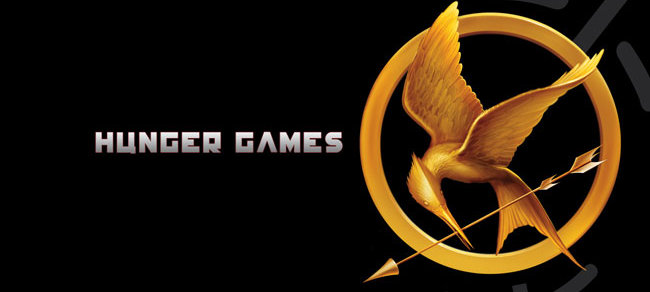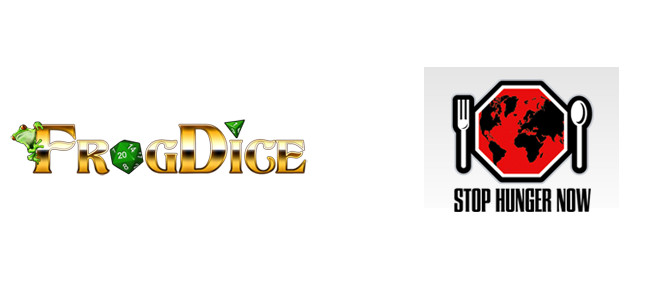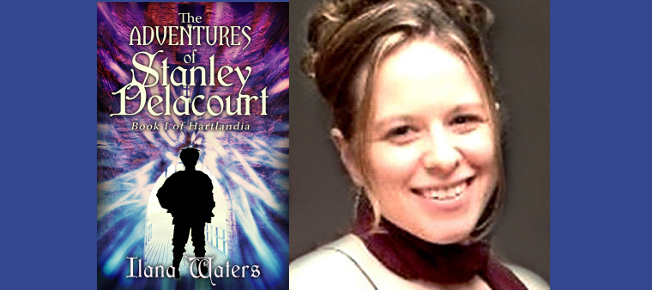Brandon and I have both started reading The Hunger Games series together and thought we would provide our unique insights in companionate reviews. First up is volume one of Suzanne Collins’ young adult series.
She Read
Katniss Everdeen: A Complete Heroine in a Fractured World
Touted as the currently most popular series in adolescent literature, The Hunger Games features a resilient heroine, Katniss Everdeen, in a dystopian North America known as Panem. Katniss lives in the outermost Zone 12, the mining district of Panem, steeped in stark poverty and degradation. (There was a Zone 13, but the central government obliterated it for their insubordination and as a warning to the other 12 zones.)
The Hunger Games presents a dystopian future of Western civilization, similar to Children of Men, 1984, V for Vendetta , or even the classic German film Metropolis. In these stories, there is always an elite class living in opulence and luxury while the masses toil in abject poverty. This dystopian society is often fractured into specialized zones or sectors with which the citizens are deeply identified. In Panem, the central government not only rations out food to the citizens in the zones while mandating hard labor for little pay, but they also host a yearly entertainment event called The Hunger Games. One boy and one girl are selected as “tributes” from each of the 12 zones to participate in the televised survival competition, killing each other until one sole survivor ultimately outwits, outplays, and outlasts the other 23 contestants. It’s presented as bloodthirsty entertainment in the tradition of The Running Man, Death Race 2000, and Mad Max Beyond Thunderdome, but unlike those films, the participants here are children. The games further deepen the dividing lines between the zones, pitting their children against one another in a grim battle to the death, subtly rebuking any swell of unity among the zones that could arise from the horror of the games themselves.
I found the setting and plot to be both intriguing and startling. I wondered how Collins could pull off the feat of presenting such violence in a young adult book. Could her narrator Katniss kill for her survival and still be considered a hero? From the beginning, it is evident that an ex Deus machina device couldn’t possibly be employed. Katniss wouldn’t stumble upon an underground revolutionary group in the Capital, she wouldn’t disarm her fellow tributes with persuasive rhetoric, and she wouldn’t martyr herself for the lives of others. The first person narration and the published presence of the follow-up two volumes assured her survival in my mind, but I kept wondering, at what cost?
I’ve always craved adventure stories featuring heroines. I adore Buffy the Vampire Slayer for the heroine who lives a double life that is both normal and supernatural. Sometimes the bogies of domestic troubles, rocky relationships, and financial struggles are more daunting than the vampires and demons Buffy slays regularly. Modeled after Superman tropes, Buffy’s double life is often unrewarding, but deeply necessary in maintaining the human race. And like Superman, Buffy follows a noble code: despite how rotten some people can be, Buffy doesn’t kill humans. The limitation is almost a flaw, but if she did cross that line, her nobility would be tarnished. She would no longer be a hero.
Collins’ book dives directly into this dilemma. While not superhuman, Katniss is stronger, faster, and smarter than most girls and boys her age – a born survivor in many respects. Like heroines such as Buffy, Katniss draws her strength from those she protects: her mother and her young sister, Prim. Again, the similarities are striking, for Buffy sacrificed herself for the love of her younger sister, too. But in The Hunger Games, Katniss has put herself in the position of either “kill or be killed,” and it is this sick twist on these games that makes them so popular with Panem. So the real crux of the story is not wondering if Katniss can win the Hunger Games, but can she do what it takes to win? Can she kill other children and live with the consequences?
Collins offers us a look at one past winner in the character of Haymitch who habitually self-medicates with alcohol decades after his victory. Observing Haymitch, Katniss wisely knows that there is no real winner of the Hunger Games and the government knows it, too. It is yet another way to subordinate the people, to keep them powerless and nearly subhuman. While Katniss is well aware of this agenda, she travels to the Capital to participate in the games. Her motivation to win lies in her maternal need to care for her mother and sister.
Panem is a depressing portrait of inequality taken to extremes. When I picture the world of Panem, especially of Zone 12, I see it as the rundown future. Black, gray, and brown colors seem to permeate the atmosphere. When Katniss travels west to what was formerly Colorado but is now the Capital, the heart of Panem, it must be like Dorothy waking up in Oz or Alice tumbling into Wonderland. All the new luxuries and bright colors abound, and yet Katniss envisions her death in this place. Like Alice and Dorothy, Katniss longs for home and she knows it will be a battle to reach it. Like Alice and Dorothy, risks will be taken and difficult decisions will be made. And like all heroes in young adult novels, Katniss will grow, will come of age, and will learn the difference of moving painfully from childhood to adulthood.
In many ways, Katniss is a preternatural adult, forced to grow up more quickly due to base necessity. Her mother is ineffectual and after her husband’s death failed to be a mother at all, laying all the responsibility upon young Katniss’ shoulders. By hunting and gathering, Katniss functions as the literal nurturer of this family of women. By focusing on the needs of others, Katniss has denied her own emotional needs. While she deeply cares for the well-being of other citizens in her zone, she denies her own personal feelings of attachment to others, whether it is her hunting partner Gale or her Hunger Games partner Peeta. Despite this denial, Katniss learns in both relationships that two people together are much more effective than one person alone.
Some reviewers have asserted that while practical and resourceful, Katniss is emotionally stunted, never asserting herself and her own desires. But again, I find this self-negating quality in Katniss to be the very mark of the hero, constantly thinking of others’ needs above her own. And from this devotion, the seeds of a revolution are actually planted in Panem. Katniss subverts the carefully scripted intentions of the Games by paying “tribute” to a fallen tribute, decorating the lifeless body with flowers and singing native songs – a gesture which moves the tribute’s fellow citizens so much, that they actually pay Katniss with a gift of bread – something that has never occurred in the Games before. The Games finally culminate in another courageous act of unity in the shape of a suicide pact, which is devised by Katniss from both cunning and exhaustion.
Suzanne Collins has given us a complete heroine with Katniss Everdeen in the fractured world of Panem. Katniss is physically and emotionally strong, able to withstand the harrowing experiences of the Hunger Games and survive intact. In doing so, she has fractured the power center itself of Panem while further unifying the disparate zones. While some reviewers remark that Katniss is not a fully actualized heroine, I think time will tell as I read the next two volumes. I suspect the love triangle of Katniss, Peeta, and Gale will move toward resolution as Panem itself moves toward revolution.
He Read
The Hunger Games: A Fascinating Imagining of a Possible Future
I’ll be the first to admit that I don’t keep up with all the popular trends. That’s why The Indie Mine has a staff to help me fill in the gaps. So it should be no surprise that prior to a month ago, I’d never even heard of the book The Hunger Games, let alone the feature film set to release next year. And after being told it compares favorably to the Twilight series, I was content with my ignorance up until that point. A reveal of the basic plot of the first novel in the series, however, turned me on my head.
The first element of the story that caught my attention is the world in which the characters exist. It’s a reconstructed North America sometime in the distant future. The general populace has been wiped out by natural disasters and war at some point in the past. I’m always intrigued by post-apocalyptic stories. I enjoy the character study involved and seeing how society has physically rebuilt itself, whether people still behave with the same morals and laws, and what the ruling/governing structure is like. In other words, I like to know what remnants of our current selves remain and what’s changed to adapt to the new world. Has society stripped out the bad or the good?
The division of Panem is a fascinating one. There’s a wealthy, technologically advanced capital along with twelve separate impoverished districts or zones. Those in the capital want for nothing while everyone else does whatever they can just to stay alive. To rise against the current power means death or worse as evidenced by the complete demolition of zone 13. The capital keeps a Big Brother-like eye on everyone and has established the barbaric Hunger Games as a way of reminding its citizens that rebellion is futile.
The Hunger Games is an annual gladiatorial style event in which two children, one boy and one girl are selected at random from each district, paraded around as mascots, and dropped off in an unknown, remote location to do battle with one another until one competitor is left alive. The whole event is broadcast to everyone in the nation like it’s the Super Bowl on steroids. Wages are often placed on the entrants and sponsors can choose to send aids to their chosen entrants for exorbitant prices. It’s a neat premise, but hardly an original one. However, it’s not often where an event forces children into a war-like setting, and perhaps that’s what first drew me to picking up the book.
The actual set-up for the event is mostly predictable. Inevitably, the protagonist, Katniss Everdeen, is going to end up in the event one way or another. Having her substitute for her little sister is a nice twist and does help to set her apart from some of the other characters. However, pitting her against Peeta, a boy from her district to whom she owes her life, is a rather obvious way to insert a moral conflict. The only more obvious choice would’ve been if her best friend Gale had been chosen and probably would’ve forced me to put away the book in disgust.
The days leading up to the start of the combat are an interesting read. The author provides great detail in all of the pomp and circumstance involved. Participants, or tributes as they are called here, are paraded around like beauty pageant contestants in order to try to garner financial support during the fight. Tributes are also evaluated on their various survival skills which are of use during the fighting. Their scores go a long way towards determining how many sponsors they will pick up. The decadence of the capital is revealed through the sheer volume and sophistication of the meals and banquets provided to everyone involved. This portion of the book provides a great look at the dichotomy between the “haves” and the “have nots” and works to draw the reader towards disdain for the ruling power.
The Hunger Games itself was a combination of both fun action and disappointing predictability. Knowing that the series is a trilogy, you never feel any real sense of danger for Katniss. However, it’s still fun to see how she eludes her pursuers and deals with the changing conditions of the environment brought on by the event organizers. The shifting alliances forged by Katniss also keep the plot interesting. As I stated before, there’s a fair amount of predictability here. In fact, of the 24 tributes, I correctly guessed who the final three would be before the fighting even started. In that sense it’s not really different from any number of Hollywood survival action movies. You know who the major players are and because of that knowledge you know they will be there at the end. The fun is in seeing how they get there.
The romance between Katniss and Peeta is played up off and on through the book once the two are selected as tributes. Naturally it was also the aspect of the story I was least looking forward to after having heard the Twilight comparisons. However, most of the actual execution and use of it I actually enjoyed. The two characters use a fictional love between the two of them to garner support from the sponsors and sympathy from just about everyone witnessing the events. They even use it to force a rather unsurprising rules change towards the end of the book. I enjoyed this aspect of the relationship; however, I did not enjoy the teen drama surrounding it. I understand that Katniss is a young character, but I couldn’t help but be annoyed by the number of times the author brought up the fact that Katniss didn’t know how Peeta felt about her. There’s a difference between being doubtful and being oblivious. Even if Katniss couldn’t put it together, the author didn’t have to keep hitting us over the head with it. Thankfully, that storyline didn’t dominate the entire book; however, it leaves me a little concerned for the sequels. I’m far more interested in how the world around Katniss will change, not which guy will shine brightest in her eyes.
For a novel aimed at a younger demographic and arguably another gender, I was surprised how much I enjoyed it. Suzanne Collins has built a fascinating world with a society and history I’m genuinely interested in learning more about. It’s my hope that in the sequel we’ll get to see much more of that world and see how the general populace’s feelings and actions towards the ruling government change after the events of The Hunger Games. I have concerns over the predictability of the story and the romantic angst of the main character, but that wasn’t enough to stop me from finishing this first title, nor will it affect my interest in the sequels.
© 2011, The Indie Mine. All rights reserved.






Good lord. I had no idea it was a young adult novel, nor that it was compared to “Twilight”. It was just a book my hairdresser raved about. I’m rather glad I didn’t know, however, as I likely wouldn’t have picked it up at all.
Nice reviews both of you. I like the two different takes.
I just finished the series this past weekend. I liked Brandon’s take on it – although I enjoyed elements, the predictability and safety I felt knowing Katniss would never suffer any real damage left me somewhat unfulfilled. I really didn’t enjoy or feel the need to elaborate so much on the love triangle between Gale, Peeta, and Katniss. Most of the time I felt like that crazy bitch just needs to make up her mind already and pick one of the two studs that are obviously bat-shit over her. What a problem to have. Although the sequels have their moments, they at times felt to be somewhat stretching things to make the plot work. Overall, pretty good series.
Now please read His Dark Materials trilogy — those books will break your brain. In a good way.
Gracie, I think Brandon may have oversold the Twilight comparison. I had read an article comparing the heroine in both series in Bitch! magazine. The only real comparative points are that both series feature an adolescent female narrator in a love triangle. Also, both series are wildly popular with adolescents.
The love triangle plot is a trope of the adolescent lit genre, I’m afraid! And the books are predictable to us seasoned readers, but probably not as so to the 12 and 13 year-olds reading them.
Erika, lol! His Dark Materials trilogy isn’t so recent anymore, I’m afraid, but if Brandon hasn’t read them, we could do that. I have to admit that I’m a little biased there. Philip Pullman was my professor (tutor) at Oxford for a while and he talked to us while he was writing the trilogy. He compared it to the Narnia series, except without “all that god crap.”
Well, know that I know it’s young adult literature, all the annoying romance nonsense makes sense. In fact, it really stands out in retrospect. I kept wondering why he didn’t just feel her up already.
I started the second book last night and I’m afraid it only gets worse.
NOW that I know, rather.
Virginia,
You have a beautiful style of writing and because of your review I am most intrigued on reading this myself. Got any more suggestions to provide to us fellow viewers?
Yes. Read my music reviews.